Capezio, the trade name of Capezio Ballet Makers Inc., has been synonymous with dancewear and footwear for over a century. The company’s origins date back to 1887 when Salvatore Capezio, an Italian immigrant and skilled cobbler, opened a small shoe repair shop near the Metropolitan Opera House in New York City. Initially focused on repairing shoes for performers at the Met, Capezio’s expertise and reputation quickly grew. A turning point came when he crafted a custom pair of shoes for Polish tenor Jean de Reszke, solidifying his shift from cobbler to bespoke shoemaker. Over time, his workshop became a hub for dancers, including the famed ballerina Anna Pavlova, who purchased Capezio pointe shoes for herself and her entire company during her U.S. tour in 1910.
As Capezio’s reputation flourished, the brand expanded its reach beyond professional dancers, becoming a staple in the world of performance art. Ben Sommers, who led the company from 1940 until his death in 1985, was instrumental in promoting dance culture across the U.S. His initiatives, like the establishment of National Dance Week and the Capezio Dance Award, helped position the brand at the forefront of the dance world. By the 1940s, Capezio had become a household name, with major retailers such as Lord & Taylor and Neiman-Marcus stocking their products. Sommers’ leadership not only strengthened Capezio’s influence but also cemented its legacy as a champion of the arts.
Today, Capezio continues to be a family-run business, blending its rich heritage with modern innovations in dancewear. Though it now utilizes computerized manufacturing systems, Capezio still upholds its tradition of handcrafting special-order footwear, ensuring the highest quality for its customers. The company has enjoyed endorsements from some of the biggest names in the entertainment industry, including Fred Astaire, Madonna, and Lady Gaga. Over the years, Capezio has remained at the intersection of dance and fashion, preserving its iconic status as a beloved brand for dancers and performers worldwide.
Capezio Shoes Commercial
How to tell if Capezio is vintage from the logo
Capezio, a brand synonymous with dancewear and footwear, has a long history of evolving its logo to reflect the aesthetics of its time. These changes in the logo can help date the vintage pieces, offering a glimpse into Capezio’s design language through the years. From script-like fonts to more modern, bold text, identifying the era of a Capezio product can often start by examining its logo. Below is a breakdown of Capezio logos from different eras based on the attached images.
1960s Capezio logo
- The logo from the 1960s is characterized by a cursive font.
- The capital “C” and lowercase letters have a hand-drawn, classic look.
- The font appears fluid, with rounded edges, reflecting the design sensibilities of the 60s.
- This era’s logo feels informal, as though written in soft brush strokes, giving it an elegant appearance.

1960s Capezio logo
1970s Capezio logo
- By the 1970s, Capezio shifted to a more structured, modern sans-serif font.
- The logo is simple, bold, and minimalist, reflecting a trend towards modernism in branding.
- The letters are evenly spaced with no embellishments, projecting a professional yet sleek identity.
- The period at the end of the logo becomes a distinctive feature of this decade’s design.

1970s Capezio logo
1970s to 1980s Capezio logo
- The 1970s to 1980s logo continues the modern, sans-serif font approach but becomes more refined.
- Lettering remains bold but gains a cleaner, more polished appearance.
- The simple aesthetic complements the dance-focused identity Capezio has built, emphasizing functionality and style.
- This version also maintains the distinctive period at the end of the brand name.

1970s to 1980s Capezio logo
1990s to 2000s Capezio logo
- In the 1990s, Capezio introduced a more dynamic and artistic element to their logo.
- The iconic dancer in mid-leap was added above the brand name, symbolizing the brand’s strong ties to dancewear.
- The text remained bold and modern, similar to earlier versions, but the logo as a whole emphasized movement and grace.
- This version saw the use of a serif font for the word “Capezio,” with more curves and softer lines than previous decades.
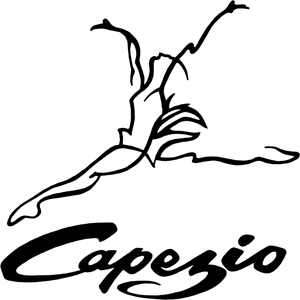
1990s to 2000s Capezio logo
2010s to now Capezio logo
- The current logo has streamlined both the text and dancer imagery, with a simpler and more abstract representation.
- The dancer remains part of the logo, but now with more fluid, minimalist lines.
- The text is presented in a clean, sans-serif font, emphasizing modernity and clarity.
- The “X” in the logo features a distinct design resembling two wings, reinforcing the idea of movement and agility.

2010s to now Capezio logo
How to tell if Capezio is vintage from the tags
Capezio is a brand with a rich history in dancewear, evolving its branding and labels over the decades. Known for its quality dance shoes and apparel since 1887, Capezio has shifted its tag designs to reflect the times, while always maintaining its iconic logo. By examining the tags, one can often identify the era from which a particular item originated. Below is a breakdown of vintage Capezio tags from various decades based on the tags provided.
Need help with vintage tags or labels? Submit a picture on our vintage tag identification page, and we’ll take care of it!
1960s vintage Capezio tags
- Bold serif lettering spelling out “Capezio” in all capital letters.
- Tags often feature a dancing figure in motion, emphasizing the brand’s roots in dance.
- “Made in U.S.A” is commonly printed, showcasing the domestic production during this period.
- The brand is referred to as “the dancemaker,” a tagline prevalent during this era.
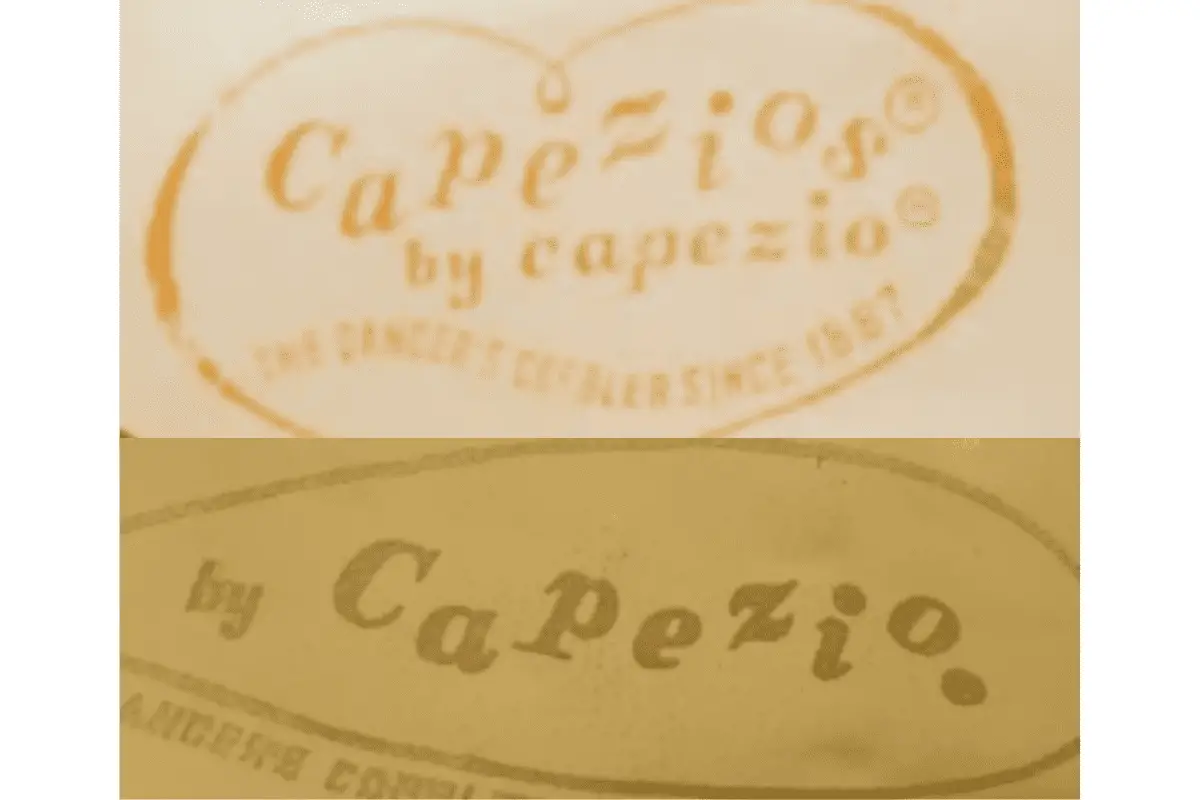
1960s Capezio tags
1970s vintage Capezio tags
- Logo displays “Capezio” in lowercase, with a playful, modern font style.
- Some tags include “By Capezio,” denoting the brand’s expansion into other product lines like street shoes.
- Tags continue to emphasize U.S. production with “Made in U.S.A.” visible.
- In some cases, product-specific details are printed directly onto the item, as seen in leather footwear tags.
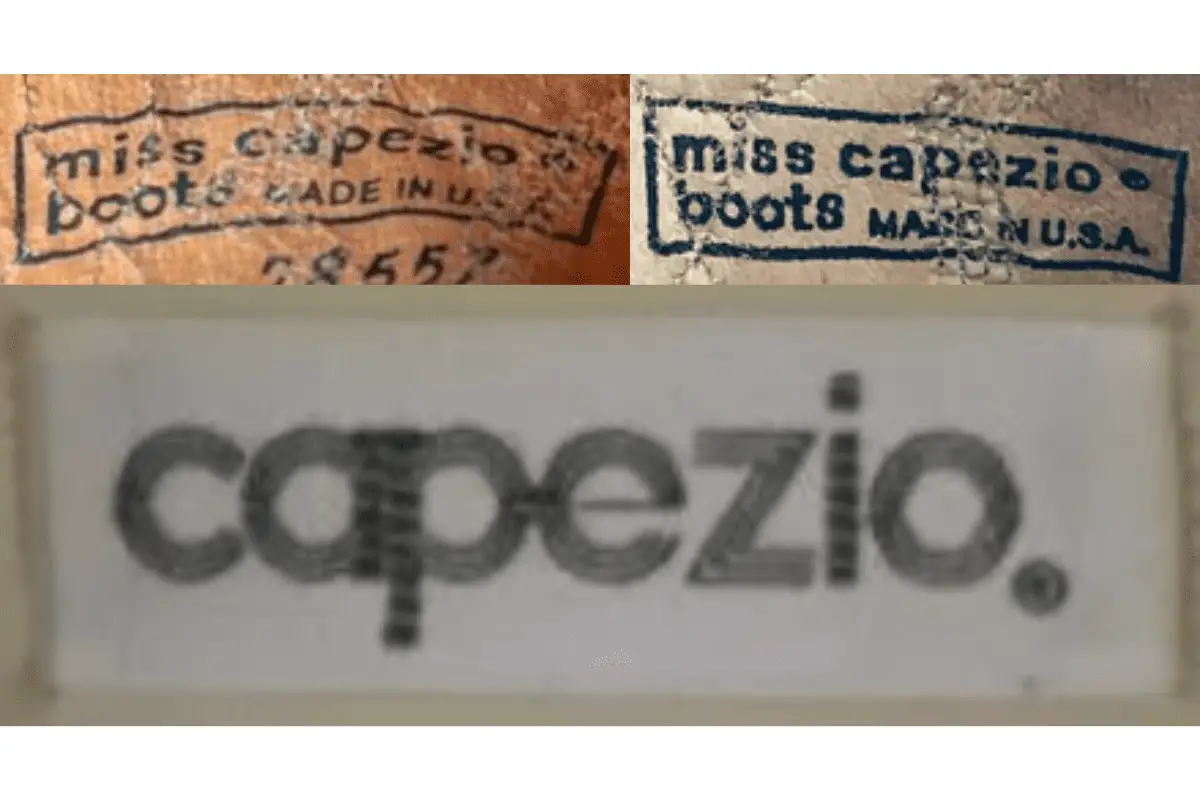
1970s Capezio tags
1980s vintage Capezio tags
- Tags from this era feature a sleek sans-serif typeface spelling “capezio” in lowercase.
- Some tags include descriptors like “Dancing Since 1887,” highlighting the brand’s long history.
- Bold contrast stitching around the tag was popular during this time, often on darker fabrics.
- Many tags indicate “Made in U.S.A.,” but tags showing production from other countries may also begin to appear.
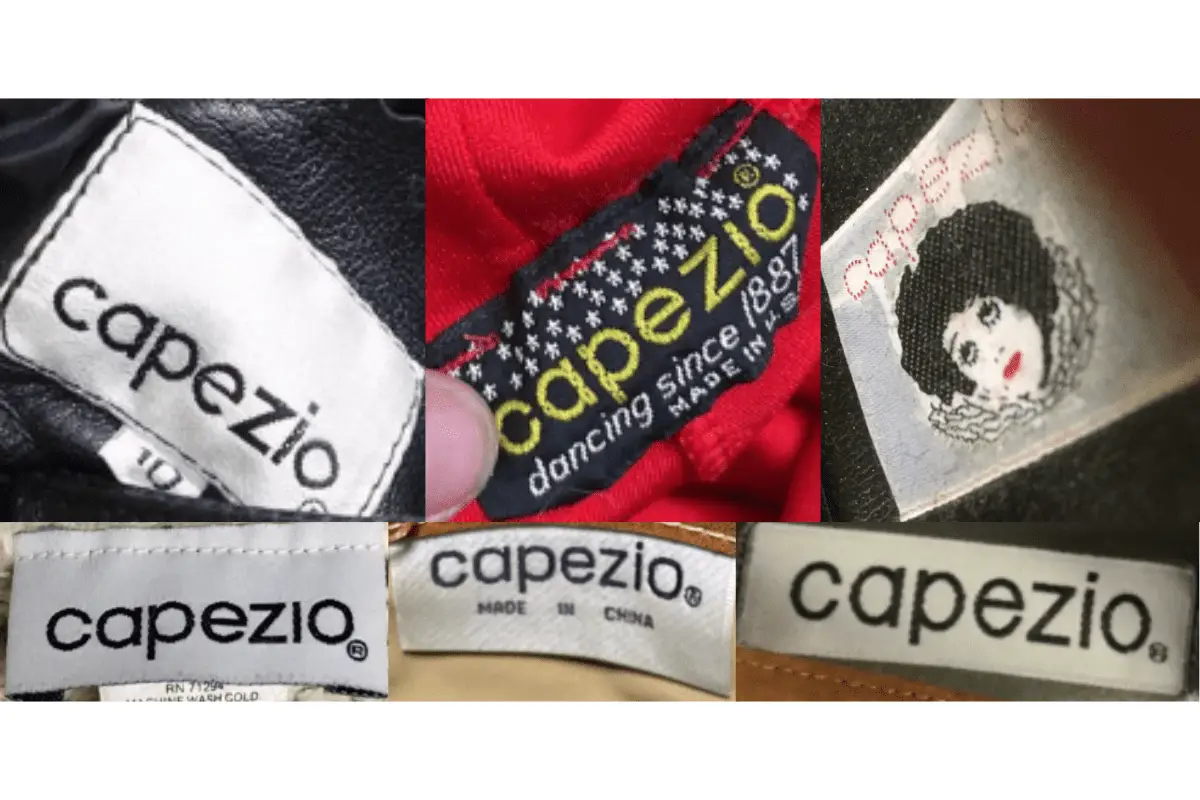
1980s Capezio tags
1990s vintage Capezio tags
- The logo continues to evolve, keeping a modernized sans-serif font for “capezio.”
- Additional fabric or care information is more prominent on the tags in this era.
- More international manufacturing locations are visible, indicating the brand’s growing global reach.
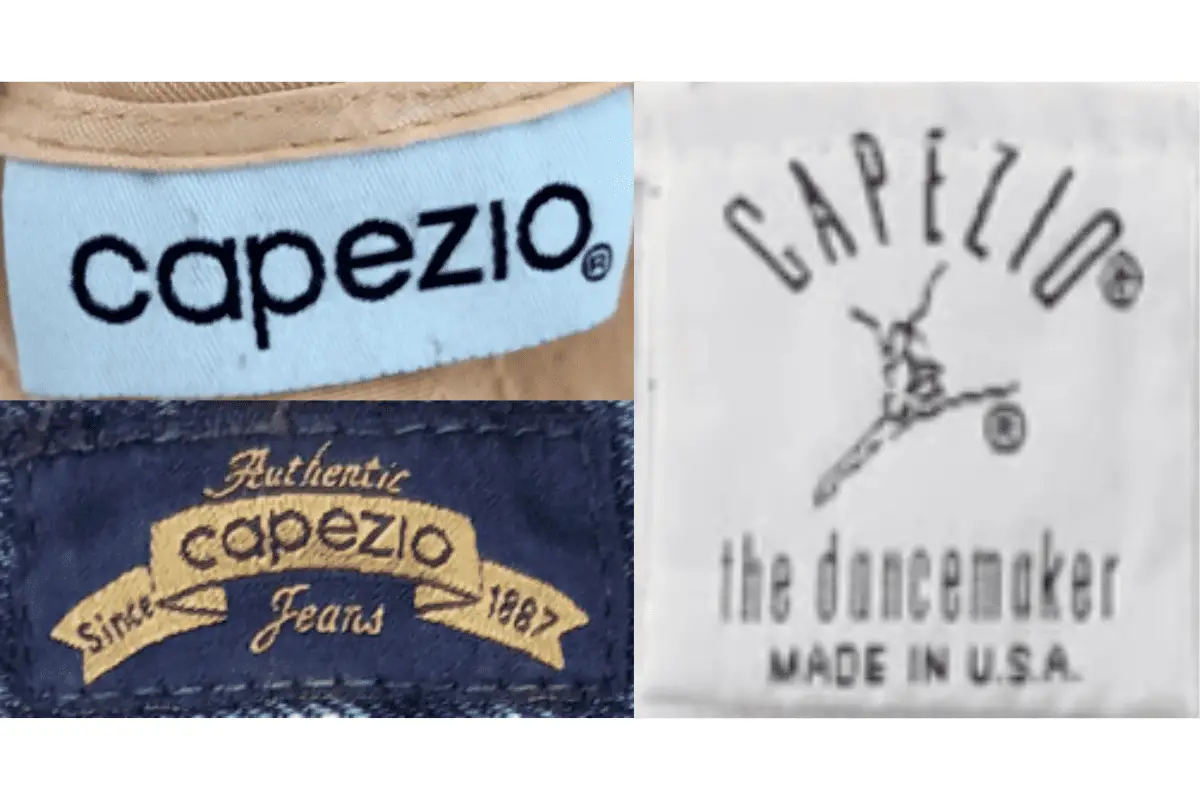
1990s Capezio tags
2000s vintage Capezio tags
- Tags feature a more polished look, often with darker backgrounds and contrasting fonts.
- The word “capezio” is still in lowercase, but the logo often incorporates more stylized font choices.
- Production has largely moved outside the U.S., with “Made in China” becoming more common on tags.
- Many tags during this period include care instructions or material details directly beneath the logo.

2000s Capezio tags
2010s vintage Capezio tags
- The modern Capezio logo now incorporates an additional flourish, with a more minimalist design.
- Tags are often more compact, reflecting global manufacturing processes, with “Made in China” commonly seen.
- New tag designs feature sleeker, more minimalistic fonts, often in red, with clear and clean presentation.
- Size indicators and material compositions are prominently included on most tags in this era.
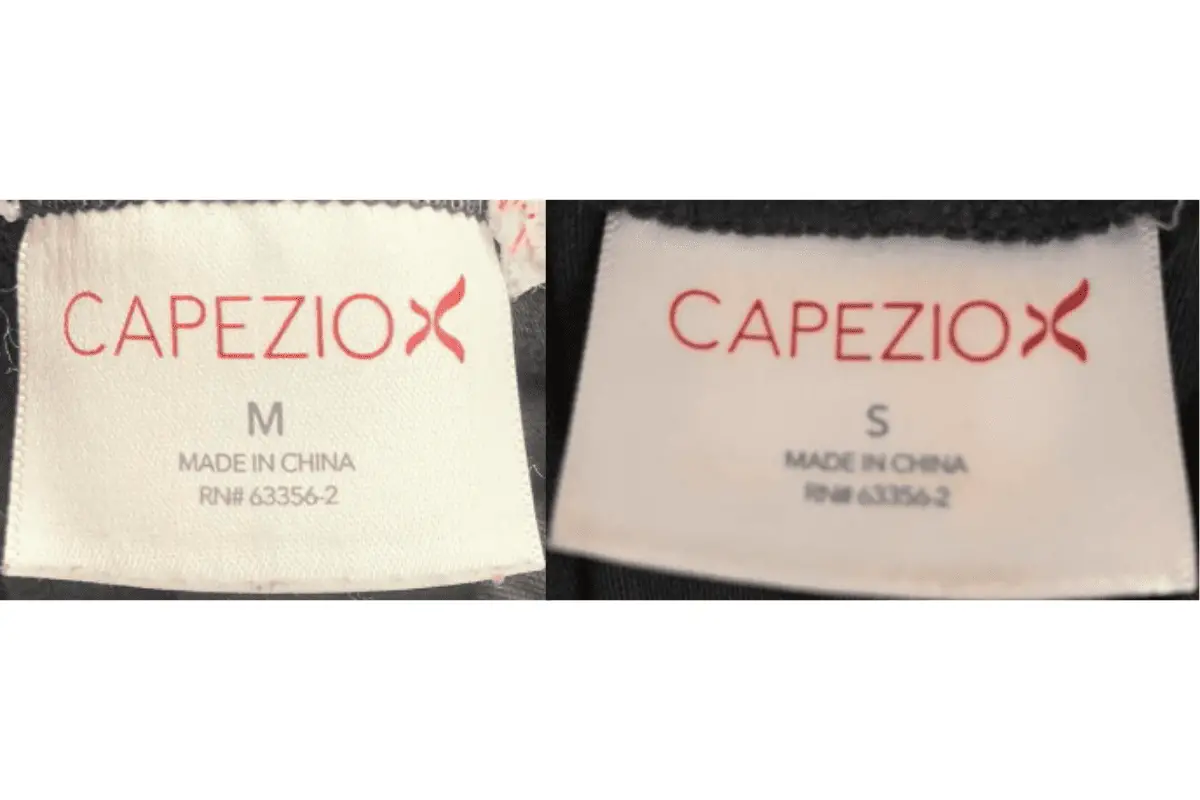
2010s Capezio tags




